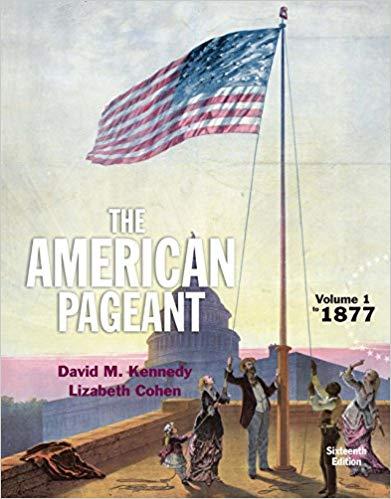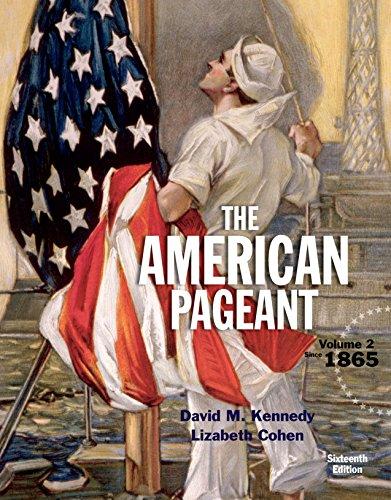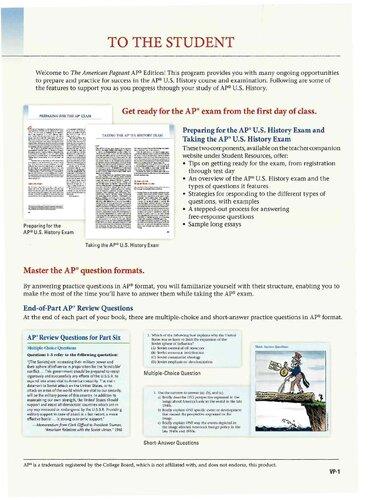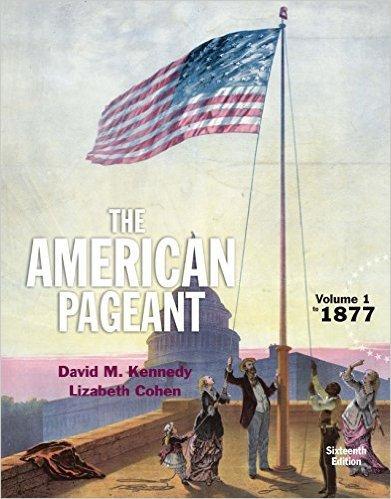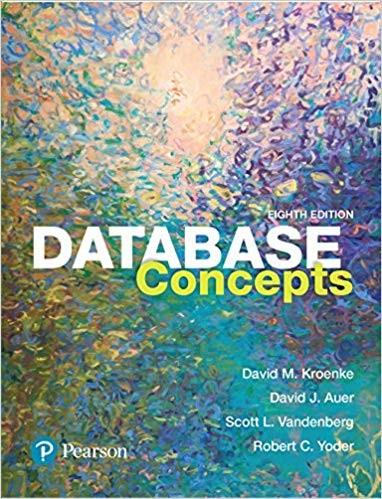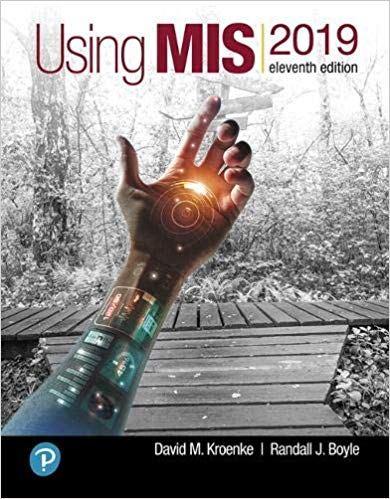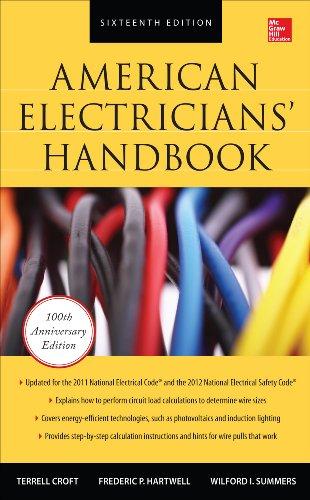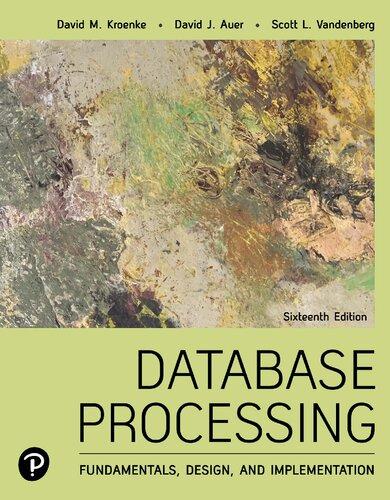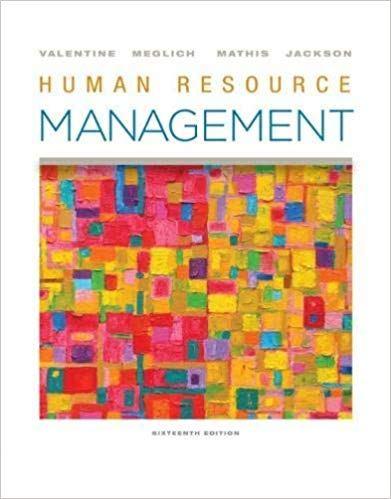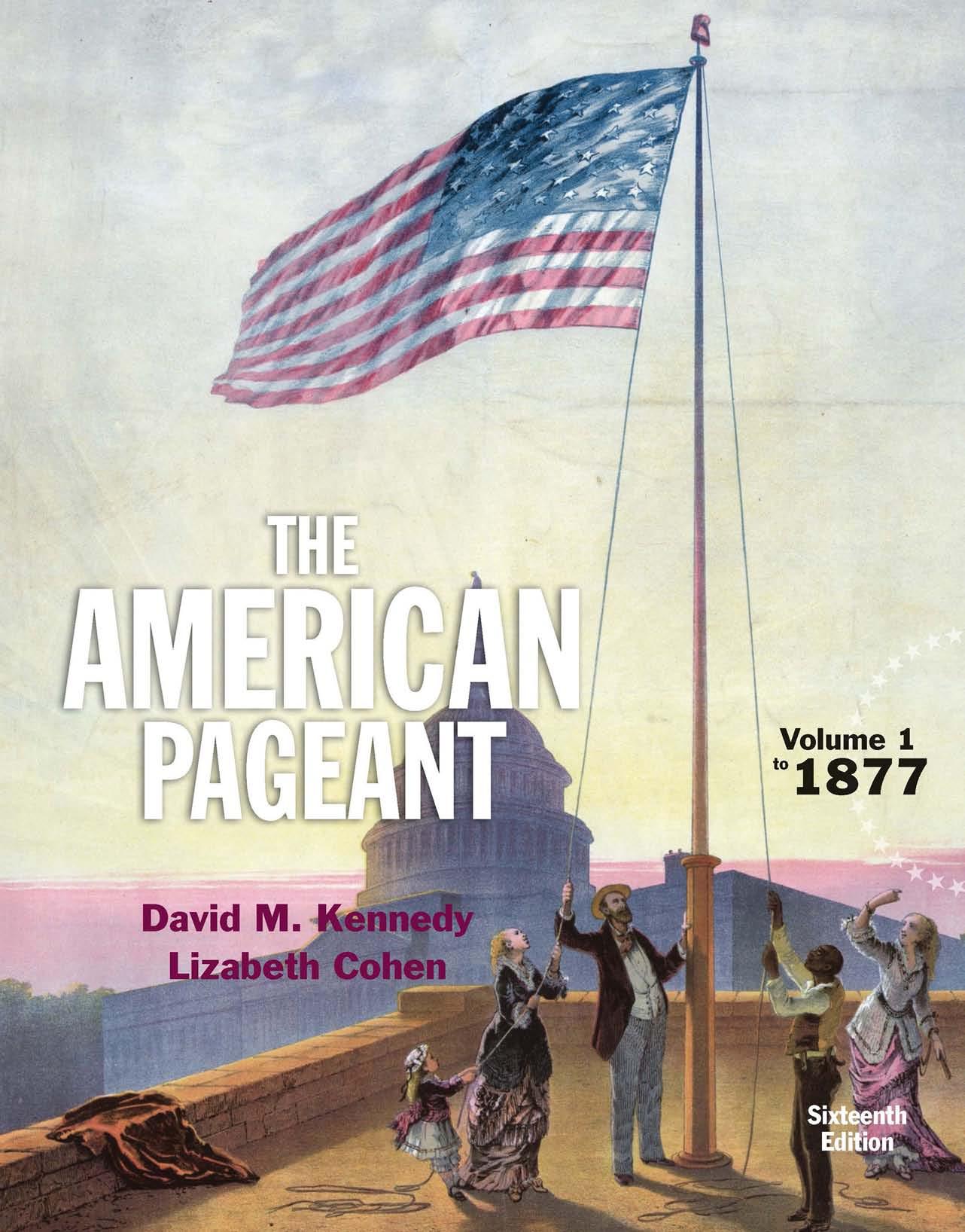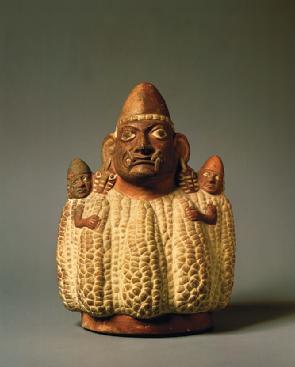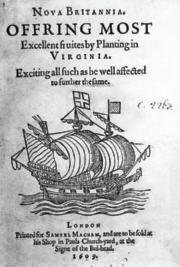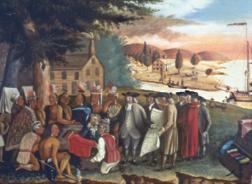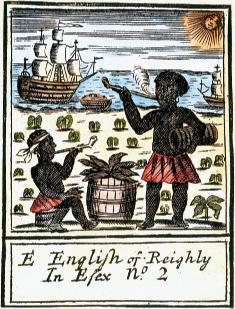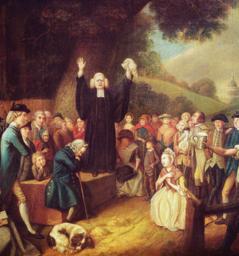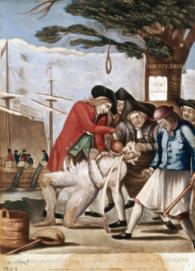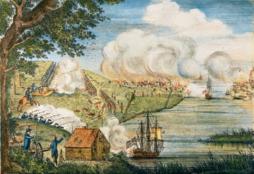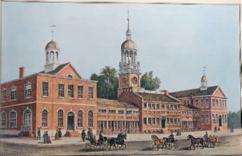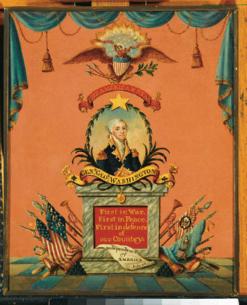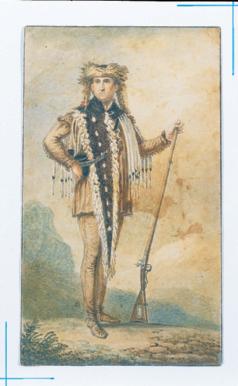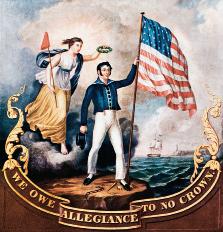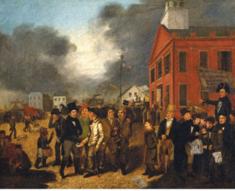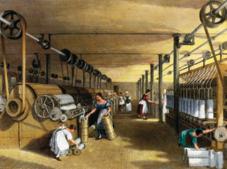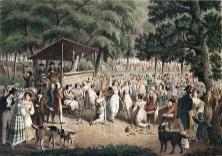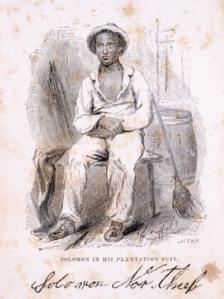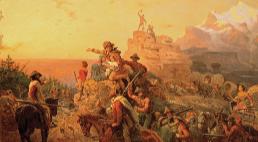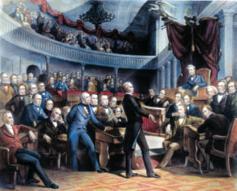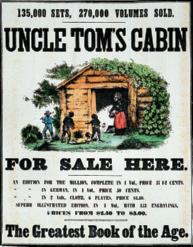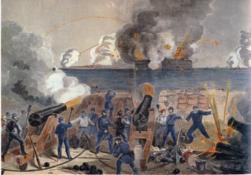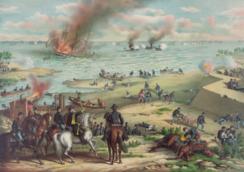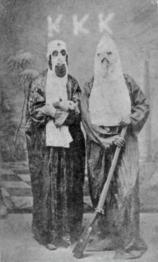br IEF C On TE n T s
Part Two
Part Three
C On TE n T s
maps xv
Tables xix
Figures xxi
Preface xxiii
Part One
Founding the new nation
ca. 33,000 b.c.e .–1783 c.e . 2
eginnings 33,000 b.c.e.–1769 c.e.
The geology of the New World • Native Americans before Columbus • Europeans and Africans • Columbus and the early explorers • The ecological consequences of Columbus’s discovery • The conquest of Mexico • Spain builds a New World empire
c hronology / K ey T erms / P
/
U ExaminingthEEvidEncE making sense of the new World 7
U contEndingvoicEs Europeans and Indians 16
U makErsofamErica The spanish Conquistadores 18
2 The Planting of English America 1500–1733
23–24
England on the eve of empire • The expansion of Elizabethan England • The planting of Jamestown, 1607 • English settlers and Native Americans • The growth of Virginia and Maryland • England in the Caribbean • Settling the Carolinas and Georgia
c hronology / K ey T
40–41
U contEndingvoicEs Old World Dreams and new World realities 27
U makErsofamErica The Iroquois 38
4
settling the northern Colonies 1619–1700
The Puritan faith • Plymouth Colony, 1620 • The Puritan commonwealth of Massachusetts Bay Colony, 1630 • Rhode Island, Connecticut, and New Hampshire • Puritans and Indians • The Confederation and Dominion of New England, 1686–1689 • New Netherland becomes New York • Pennsylvania, the Quaker colony • New Jersey and Delaware
c hronology / K ey T erms / P eo P le T o K now / T o l earn m ore 60–61
U contEndingvoicEs Anne Hutchinson Accused and Defended 47
U ExaminingthEEvidEncE A seventeenth-Century Valuables Cabinet 58
U varyingviEwpoints Europeanizing America or Americanizing Europe? 59
American life in the seventeenth Century 1607–1692
Life and labor in the Chesapeake tobacco region • Indentured servants and Bacon’s Rebellion in Virginia, 1676 • The spread of slavery • African American culture • Southern Society • Families in New England • Declining Puritan piety • The Salem witchcraft trials, 1692 • Daily life in the colonies
c hronology / K ey T erms / P eo P le T o K now / T o l earn m ore 76–77
U contEndingvoicEs berkeley Versus bacon 64
U ExaminingthEEvidEncE An Indentured servant’s Contract, 1746 65
U thinkingglobally The Atlantic slave Trade, 1500–1860 66
5 Colonial society on the Eve of revolution 1700–1775
Immigration and population growth • African American culture • Colonial social structure • Earning a living • The Atlantic economy • The role of religion • The Great Awakening of the 1730s • Education and culture • Politics and the press • Colonial folkways
c hronology / K ey T erms / P eo P le T o K now / T o l earn m ore 99–100
U contEndingvoicEs race and slavery 81
U makErsofamErica From African to African American 82
U varyingviEwpoints Colonial America: Communities of Conflict or Consensus? 98
The Duel for north America 1608–1763
New France • Fur-traders and Indians • Anglo-French colonial rivalries • Europe, America, and the first world wars • The Seven Years’ War • Pontiac’s uprising and the Proclamation of 1763
c hronology / K ey T erms / P eo P le T o K now / T o l earn m ore 115–116
U contEndingvoicEs The Proclamation of 1763 113
7 The road to revolution 1763–1775
8
Roots of revolution • The merits and menace of mercantilism • The Stamp Act crisis, 1765 • The Townshend Acts, 1767 • The Boston Tea Party, 1773 • The Intolerable Acts and the Continental Congress, 1774 • Lexington, Concord, and the gathering clouds of war, 1775 • The rebel army
c hronology / K ey T erms / P eo P le T o K now / T o l earn m ore 134
U contEndingvoicEs reconciliation or Independence? 121
U thinkingglobally Imperial rivalry and Colonial revolt 130
America secedes from the Empire 1775–1783
Early skirmishes, 1775 • American “republicanism” • The Declaration of Independence, 1776 • Patriots and Loyalists • The fighting fronts • The French alliance, 1778 • Yorktown, 1781 • The Peace of Paris, 1783
c hronology / K ey T erms / P eo P le T o K now / T o l earn m ore 157
U ExaminingthEEvidEncE A Revolution for Women? Abigail Adams Chides Her Husband, 1776 142
U makErsofamErica The loyalists 144
U contEndingvoicEs Two revolutions: French and American 154
U varyingviEwpoints Whose revolution? 156
1776–1790
Changing political sentiments • The new state constitutions • Economic troubles • The Articles of Confederation, 1781–1788 • The Northwest Ordinance, 1787 • Shays’s Rebellion, 1786 • The Constitutional Convention, 1787 • Ratifying the Constitution, 1787–1790
c hronology / K ey T erms / P
/ T o
ore 181
U ExaminingthEEvidEncE Copley Family Portrait, ca. 1776–1777 162
U contEndingvoicEs Debating the new Constitution 177
U varyingviEwpoints The Constitution: revolutionary or Counterrevolutionary? 180
l aunching the new ship of state 1789–1800
Problems of the young republic • The first presidency, 1789–1793 • The Bill of Rights, 1791 • Hamilton’s economic policies • The emergence of political parties • The impact of the French Revolution • Jay’s Treaty, 1794, and Washington’s farewell, 1797 • President Adams keeps the peace • The Alien and Sedition Acts, 1798 • Federalists versus Republicans
c hronology / K ey T erms / P eo P le T o K now / T o l earn m ore 202–203
U contEndingvoicEs Human nature and the nature of Government 187
U thinkingglobally Two revolutions 190
11 The Triumphs and Travails of the Jeffersonian republic
1800 –1812
The “Revolution of 1800” • The Jefferson presidency • John Marshall and the Supreme Court • Barbary pirates • The Louisiana Purchase, 1803 • The Anglo-French War • The Embargo, 1807–1809 • Madison gambles with Napoleon • Battle with the Shawnees • A Declaration of War
c hronology / K ey T erms / P eo P le T o K now / T o l earn m ore 224–225
U ExaminingthEEvidEncE The Thomas Jefferson–sally Hemings Controversy 207
U contEndingvoicEs The Divisive Embargo 219
12 The second War for Independence and the upsurge of nationalism 1812–1824
Invasion of Canada, 1812 • The war on land and sea • The Treaty of Ghent, 1814 • The Hartford Convention, 1814–1815 • A new national identity • “The American System” • James Monroe and the Era of Good Feelings • Westward expansion • The Missouri Compromise, 1820 • The Supreme Court under John Marshall • Oregon and Florida • The Monroe Doctrine, 1823
c hronology / K ey T erms / P eo P le T o K now / T o l earn m ore 246–247
U makErsofamErica settlers of the Old northwest 238
U contEndingvoicEs sizing up the monroe Doctrine 245
The r ise of a mass Democracy 1824–1840
The “corrupt bargain” of 1824 • President John Quincy Adams, 1825–1829 • The triumph of Andrew Jackson, 1828 • The spoils system • The “Tariff of Abominations,” 1828 • The South Carolina nullification crisis, 1832–1833 • The removal of the Indians from the Southeast • Jackson’s war on the Bank of the United States • The emergence of the Whig party, 1836 • Martin Van Buren in the White House, 1837–1841 • Revolution in Texas • William Henry Harrison’s “log cabin” campaign, 1840 • Mass democracy and the two-party system
c hronology / K ey T erms / P eo P le T o K now / T o l earn m ore 276–277
U contEndingvoicEs Taking the measure of Andrew Jackson 252
U thinkingglobally Alexis de Tocqueville on Democracy in America and Europe 254
U ExaminingthEEvidEncE satiric bank note, 1837 265
U makErsofamErica mexican or Texican? 270
U varyingviEwpoints What Was Jacksonian Democracy? 275
14
Forging the national Economy 1790–1860
The westward movement • European immigration • The Irish and the Germans • Nativism and assimilation • The coming of the factory system • Industrial workers • Women and the economy • The ripening of commercial agriculture • The transportation revolution • A continental economy
c hronology / K ey T erms / P eo P le T o K now / T o l earn m ore 307–308
U makErsofamErica The Irish 284
U contEndingvoicEs Immigration, Pro and Con 287
U makErsofamErica The Germans 288
U ExaminingthEEvidEncE The Invention of the sewing machine 294
15 The Ferment of reform and Culture 1790–1860
Religious revivals • The Mormons • Educational advances • The roots of reform • Temperance • Women’s roles and women’s rights • Utopian experiments • Scientific progress • Artistic expressions • A national literature • Transcendentalism • Poets, novelists, and historians
c
/ K
U ExaminingthEEvidEncE Dress as reform 321
U contEndingvoicEs The role of Women 322
U makErsofamErica The Oneida Community 324
336–337
U varyingviEwpoints reform: Who? What? How? and Why? 335
The south and the slavery
The economy of the Cotton Kingdom • Southern social structure • Poor whites and free blacks • The plantation system • Life under slavery • The abolitionist crusade • The white Southern response • Abolition and the Northern conscience
c hronology / K ey T erms / P eo P le T o K
/ T o l earn m ore 361–362
U contEndingvoicEs Perspectives on race and slavery 351
U ExaminingthEEvidEncE Bellegrove Plantation, Donaldsville, louisiana, built 1857 354
U thinkingglobally The struggle to Abolish slavery 356
U varyingviEwpoints What Was the True nature of slavery? 359
17 manifest Destiny and Its l egacy 1841–1848
“Tyler Too” becomes president, 1841 • Fixing the Maine boundary, 1842 • The annexation of Texas, 1845 • Oregon Fever • James K. Polk, the “dark horse” of 1844 • War with Mexico, 1846–1848
c hronology / K ey T erms / P
/
U contEndingvoicEs Warring over the mexican War 375
U makErsofamErica The Californios 378 18 renewing the sectional struggle 1848–1854
380
“Popular sovereignty” • Zachary Taylor and California statehood • The underground railroad • The Compromise of 1850 • The Fugitive Slave Law • President Pierce and expansion, 1853–1857 • Senator Douglas and the Kansas-Nebraska Act, 1854
c hronology / K ey T erms / P eo P le T o K now / T o l earn m ore 398
U contEndingvoicEs The Compromise of 1850 390
19
Drifting
22 The Ordeal of reconstruction 1865–1877
A ppendix
Documents A1
The defeated South • The freed slaves • President Andrew Johnson’s Reconstruction policies • The Black Codes • Congressional Reconstruction policies • Johnson clashes with Congress • Military Reconstruction, 1867–1877 • Freed people enter politics • “Black Reconstruction” and the Ku Klux Klan • The impeachment of Andrew Johnson • The legacy of Reconstruction c hronology / K ey T erms / P eo P le T o K now / T o l earn m ore 484–485
U ExaminingthEEvidEncE letter from a Freedman to His Old master, 1865 468
U contEndingvoicEs radical republicans and southern Democrats 473
U varyingviEwpoints How radical Was reconstruction? 483
Declaration of Independence • Constitution of the United States of America
Tables A21
Presidential Elections • Presidents and Vice Presidents • Admission of States • Estimates of Total Costs and Number of Battle Deaths of Major U.S. Wars
Glossary of Key Terms A27
Index I1
1.1 The First Discoverers of America 6
1.2 North American Indian Peoples at the Time of First Contact with Europeans 9
1.3 The World Known to Europe and Major Trade Routes with Asia, 1492 11
1.4 Principal Voyages of Discovery 17
1.5 Principal Early Spanish Explorations and Conquests 21
1.6 Spain’s North American Frontier, 1542–1823 22
2.1 Early Maryland and Virginia 29
2.2 Early Carolina and Georgia Settlements 36
2.3 Iroquois Lands and European Trade Centers, ca. 1590–1650 38
3.1A Sources of the Puritan “Great English Migration” to New England, c. 1620–1640 45
3.1B The Great English Migration, ca. 1630–1642 45
3.2 Seventeenth-Century New England Settlements 48
3.3 Andros’s Dominion of New England 51
3.4 Early Settlements in the Middle Colonies, with Founding Dates 52
4.1 Main Sources and Destinations of African Slaves, ca. 1500–1860 67
5.1 Immigrant Groups in 1775 79
5.2 The Colonial Economy 86
5.3 Colonial Trade Patterns, ca. 1770 87
6.1 France’s American Empire at Its Greatest Extent, 1700 102
6.2 Fur-Trading Posts 103
6.3 Scenes of the French Wars 104
6.4 North America After Two Wars, 1713 105
6.5 The French and Indian War in North America, 1754–1760 107
6.6 Global Scale of the Seven Years’ War 108
6.7A North America Before 1754 111
6.7B North America After 1763 (after French losses) 111
6.8 British Colonies at End of the Seven Years’ War, 1763 114
7.1 Québec Before and After 1774 127
8.1 Revolution in the North, 1775–1776 138
8.2 War in the South, 1780–1781 151
8.3 George Rogers Clark’s Campaign, 1778–1779 152
9.1 Western Land Cessions to the United States, 1782–1802 164
9.2 Surveying the Old Northwest Under the Land Ordinance of 1785 166
9.3 Main Centers of Spanish and British Influence After 1783 167
9.4 The Struggle over Ratification 175
10.1 American Posts Held by the British and British-American Clashes After 1783 193
11.1 Presidential Election of 1800 (with electoral vote by state) 206
11.2 The Barbary States of North Africa and the Burning of the Frigate Philadelphia, 1804 212
11.3 Exploring the Louisiana Purchase and the West 217
12.1 Battles in the War of 1812 227
12.2 Presidential Election of 1812 (with electoral vote by state) 231
12.3 The Missouri Compromise and Slavery, 1820–1821 237
12.4 U.S.-British Boundary Settlement, 1818 242
12.5 The Southeast, 1810–1819 242
12.6 The West and Northwest, 1818–1824 246
13.1 Presidential Election of 1828 (with electoral vote by state) 252
13.2 Indian Removals, 1830–1846 260
13.3 The Texas Revolution, 1836 269
14.1 Westward Movement of Center of Population, 1790–2010 279
14.2 Major Rivers, Roads, and Canals, 1825–1860 300
14.3 The Railroad Revolution 301
14.4 Main Routes West Before the Civil War 303
14.5 Industry and Agriculture, 1860 305
15.1 The Mormon World 313
16.1 Southern Cotton Production and Distribution of Slaves, 1820–1860 344
16.2 Southern Cotton Production and Distribution of Slaves, 1820–1860 345
16.3 Early Emancipation in the North 352
17.1 Maine Boundary Settlement, 1842 366
17.2 The Oregon Controversy, 1846 371
17.3 Major Campaigns of the Mexican War 374
17.4 Spanish Missions and Presidios 379
18.1 California Gold Rush Country 383
18.2 Texas and the Disputed Area Before the Compromise of 1850 385
18.3 Slavery After the Compromise of 1850 389
18.4 The Legal Status of Slavery, from the Revolution to the Civil War 391
18.5 Central America, ca. 1850, Showing British Possessions and Proposed Canal Routes 392
18.6 The Gadsden Purchase, 1853 395
18.7 Kansas and Nebraska, 1854 396
19.1 Bleeding Kansas, 1854–1860 402
19.2 Presidential Election of 1856 (electoral vote by state) 406
19.3 Presidential Election of 1860: Electoral Vote by State (top) and Popular Vote by County (bottom) 414
19.4 Southern Opposition to Secession, 1860–1861 (showing vote by county) 415
20.1 Seceding States (with dates and order of secession) 423
21.1 Peninsula Campaign, 1862 440
21.2 Main Thrusts, 1861–1865 441
21.3 Emancipation in the South 445
21.4 The Battle of Gettysburg, 1863 448
21.5 The Mississippi River and Tennessee, 1862–1863 451
21.6 Sherman’s March, 1864–1865 452
21.7 Presidential Election of 1864 (showing popular vote by county) 456
21.8 Grant’s Virginia Campaign, 1864–1865 457
22.1 Military Reconstruction, 1867 (five districts and commanding generals) 476
22.2 Alaska and the Lower Forty-Eight States (a size comparison) 482
2.1 The Tudor Rulers of England 26
2.2 The Thirteen Original Colonies 35
3.1 The Stuart Dynasty in England 50
5.1 Established (Tax-Supported) Churches in the Colonies, 1775 89
5.2 Estimated Religious Census, 1775 89
5.3 Colonial Colleges 93
6.1 Later English Monarchs 104
6.2 The Nine World Wars 106
8.1 Britain Against the World 150
9.1 Evolution of Federal Union 171
9.2 Slavery and the Constitution 173
9.3 Strengthening the Central Government 174
9.4 Ratification of the Constitution 175
10.1 Evolution of the Cabinet 183
10.2 Evolution of Major Parties 189
10.3 The Two Political Parties, 1793–1800 200
13.1 Election of 1824 249
13.2 Voter Turnout by Country, 1840–2008 255
14.1 Irish and German Immigration by Decade, 1830–1900 281
16.1 Comparative Abolition of Slavery 357
17.1 House Vote on Tariff of 1846 371
18.1 Compromise of 1850 387
19.1 Election of 1860 413
20.1 Manufacturing by Sections, 1860 425
20.2 Immigration to United States, 1860–1866 428
20.3 Number of Men in Uniform at Date Given 434
22.1 Principal Reconstruction Proposals and Plans 471
22.2 Southern Reconstruction by State 477
Table A.1 Presidential Elections A21
Table A.2 Presidents and Vice Presidents A24
Table A.3 Admission of States A26
Table A.4 Estimates of Total Costs and Number of Battle Deaths of Major U.S. Wars A26
FIG
ur E s
1.1 The Arc of Time 5
1.2 The Columbian Exchange 15
5.1 Ethnic and Racial Composition of the American People, 1790 80
10.1 Hamilton’s Financial Structure Supported by Revenues 186
14.1 Population Increase, Including Slaves and Indians, 1790–1860 281
16.1 Slaveowning Families, 1850 343
21.1 Union Party, 1864 454
Pr EFACE
This sixteenth edition of The American Pageant reflects our continuing collaboration to bring the most recent scholarship about American history to the broadest possible student audience, while preserving the readability that has long been the Pageant’s hallmark. We are often told that the Pageant stands out as the only American history text with a distinctive personality, an observation that brings us considerable satisfaction. We define the Pageant’s leading characteristics as clarity, concreteness, a strong emphasis on major themes, integration of a broad range of historical topics into a coherent and clutter-free narrative, attention to a variety of interpretive perspectives, and a colorful writing style leavened, as appropriate, with wit. That personality, we strongly believe, is what has made the Pageant both appealing and useful to countless students for more than six decades.
Our collaboration on the Pageant reflects our respective scholarly interests, which are complementary to a remarkable degree. While we share broad interests in the evolving character of American society and in its global role, David Kennedy is primarily a political and economic historian, while Lizabeth Cohen’s work emphasizes social and cultural history. Together, we have once again revised the Pageant chapter by chapter, even paragraph by paragraph, guided by our shared commitment to tell the story of the American past as vividly and clearly as possible, without sacrificing a sense of the often sobering seriousness of history and of its sometimes challenging complexity.
Goals of The American Pageant
Like its predecessors, this edition of The American Pageant seeks to cultivate in its readers the critical thinking skills necessary for balanced judgment and informed understanding about American society by holding up to the present the mirror and measuring rod that is the past. The division of the book into six parts, each with an introductory essay, encourages students to understand that the study of history is not just a matter of piling up mountains of facts but is principally concerned with discovering complex patterns of change over time and organizing seemingly disparate events, actions, and ideas into meaningful chains of cause and consequence.
A strong narrative propels the story, reinforced in this edition by a new feature, “Contending Voices,”
that presents paired quotes from the past to encourage critical thinking about controversial issues. Still more highlighted quotes throughout the text help students hear the language of real people who shaped and experienced historical events. In addition, “Examining the Evidence” features enable students to deepen their understanding of the historical craft by conveying how historians develop interpretations of the past through research in many different kinds of primary sources. Here students learn to probe a wide range of historical documents and artifacts: correspondence between Abigail and John Adams in 1776, and what it reveals about women’s place in the American Revolution; the Gettysburg Address and the light it sheds not only on President Lincoln’s brilliant oratory but also on his vision of the American nation; a letter from a black freedman to his former master in 1865 that illuminates his family’s experience in slavery as well as their hopes for a new life; the manuscript census of 1900 and what it teaches us about immigrant households on the Lower East Side of New York at the dawn of the twentieth century; a new kind of architectural structure—the shopping mall—and how it changed both consumers’ behavior and politicians’ campaign tactics after World War II; and a national security document that gives insight into the foreign policy-making process.
The Pageant’s goal is not to teach the art of prophecy but the much subtler and more difficult arts of seeing things in context, of understanding the roots and direction and pace of change, and of distinguishing what is truly new under the sun from what is not. The study of history, it has been rightly said, does not make one smart for the next time, but wise forever.
We hope that the Pageant will help to develop the art of critical thinking in its readers and that those who use the book will take from it both a fresh appreciation of what has gone before and a seasoned perspective on what is to come. We hope, too, that readers will take as much pleasure in reading The American Pageant as we have had in writing it.
Changes in the Sixteenth Edition
As in past revisions, we have updated and streamlined the entire text narrative, while our main focus in this new edition is a major revision of Part Six, comprising the seven chapters covering 1945 to the present.
The Post–World War II Era
Making sense of the more recent past poses unique challenges, as scholars assessing events and personalities only just passing into the realm of “history” have had less time to develop an agreed master narrative. But we believe that sufficient time has passed for historians to have reached at least a tentative interpretative framework for understanding the post-1945 period of American history. Accordingly, we have been especially concerned to impart greater thematic coherence to this part of the text in this sixteenth edition.
Reflecting an emerging scholarly consensus, our framework for the post-1945 period roughly divides it into two eras, which can be summarized as follows: a midcentury era defined by sustained economic growth, broadly shared prosperity, and the international context of Cold War confrontation with the Soviet Union, followed by a new historical phase, originating in the pivotal decade of the 1970s, that has seen more fitful growth alongside both decreasing economic equality and increasing social inclusiveness, as well as a struggle to define America’s international role after the collapse of the Soviet Union in 1991. The introductory essay to Part Six (Chapters 35–41) clarifies this interpretive scheme and directs students’ attention to significant details in the extensively rewritten chapters that follow. Here, as throughout the text, we believe that anchoring the narrative of events in a coherent interpretive framework facilitates readers’ acquisition of important historical thinking skills, including periodization, synthetic reasoning, and contextual and comparative analysis.
Additional revisions in this section further enhance the development of key historical thinking skills while incorporating the insights of newer scholarship. A new “Thinking Globally” essay, “The Global 1960s” (Chapter 37), places the youth politics of that era in an international and comparative context, while a new “Examining the Evidence” item on a George W. Bush–era national security document (Chapter 41) grapples explicitly with the task of crafting sound arguments from controversial historical evidence. The “Thinking Globally” essay on globalization (now in Chapter 38) has been substantially revised to emphasize the changing international economic context for domestic U.S. developments beginning in the 1970s. “Varying Viewpoints” essays on the 1960s (Chapter 37) and conservatism (Chapter 39) have also been updated extensively to incorporate new historiography and to emphasize the challenges of weighing differing historical interpretations. Finally, we have thoroughly revamped and updated the final chapter (41) to provide a coherent narrative of major events from 2001 through 2014.
“Contending Voices”
We have added a new feature to each chapter, designed to nurture students’ historical thinking skills by exposing them to the contested nature of history as well as historical interpretation. “Contending Voices” offers paired quotes from original historical sources, accompanied by questions that ask students to assess conflicting perspectives on often hotly contested subjects. The feature complements the historiographical debates covered in the “Varying Viewpoints” essays by highlighting the ways in which historical actors themselves have debated the meaning of events in which they played roles.
Global Context
We have once again deepened the Pageant’s treatment of the global context of American history. Today, political leaders, capital investment, consumer products, rock bands, the Internet, and much else constantly traverse the globe. But even before sophisticated technology and mass communication, complex exchanges among peoples and nations around the world deeply shaped the course of American history. Students will frequently encounter in these pages the people, ideas, and events that crossed national borders to influence the experience of the United States. They will also be invited to compare salient aspects of American history with developments elsewhere in the world. We believe that a full understanding of what makes America exceptional requires knowing about other societies and knowing when and why America’s path followed or departed from that taken by other nations.
Within each chapter, both text and graphics help students compare American developments to developments around the world. The frontier experience, railroad building, cotton production, city size and urban reform strategies, immigration, automobile ownership, the economic effects of the Great Depression, women’s participation in voting and the work force, the cultural upheavals of the 1960s, and much more should now be understood as parts of world trends, not just as isolated American phenomena. New boxed quotes bring more international voices to the events chronicled in the Pageant’s historical narrative. Updated “Varying Viewpoints” essays reflect new interpretations of significant trends and events, emphasizing, when appropriate, their global contexts.
We have revised and expanded the “Thinking Globally” essays, which present different aspects of the American experience contextualized within world history. Readers learn how developments in North America were part of worldwide phenomena,
be it the challenge to empire in the eighteenth century, the rise of socialist ideology in the nineteenth century, or the globalization that followed World War II in the twentieth century. Students also see how key aspects of American history—such as participating in the slave trade and its abolition, making a revolution for independence, creating an integrated national state in the mid-nineteenth century, and struggling to survive the Great Depression and World War II—were encountered by other nations but resolved in distinctive ways according to each country’s history, cultural traditions, and political and economic structures.
This edition also gives renewed attention to teaching strategies and pedagogical materials aimed at helping students deepen their comprehension of American history. New visual materials—documentary images, graphs, and tables—illuminate complex and important historical ideas. Readers will also find redesigned maps with topographical detail and clear labeling to better communicate the text’s analytical points. Key terms are printed in bold in each chapter and defined in a glossary at the end of the book. Every chapter concludes with an expanded chronology and a list of readable books to consult in order “To Learn More.” In addition, a list of the chapter key terms and a list of “People to Know”—created to help students focus on the most significant people introduced in that chapter—appear at the end of each chapter to help students review chapter highlights. A revised Appendix contains annotated copies of the Declaration of Independence and Constitution and key historical events and dates, such as admission of the states and presidential elections.
See the Supplements section that follows for a complete description of the many materials found online. It is our hope that readers will view online resources such as MindTap and Aplia, as an exploratory laboratory enhancing The American Pageant’s text.
Notes on Content Revisions
Chapter 1: New World Beginnings 33,000 b.c.e .–1769 c.e .
• New Contending Voices: “Europeans and Indians” (Juan Ginés de Sepulveda, Bartolomé de las Casas)
Chapter 2: The Planting of English America 1500–1733
• New Contending Voices: “Old World Dreams and New World Realities” (Richard Hakluyt, George Percy)
Chapter 3: Settling the Northern Colonies 1619–1700
• New Contending Voices: “Anne Hutchinson Accused and Defended” (John Winthrop, Anne Hutchinson)
Chapter 4: American Life in the Seventeenth Century 1607–1692
• New Contending Voices: “Berkeley Versus Bacon” (Nathaniel Bacon, William Berkeley)
Chapter 5: Colonial Society on the Eve of Revolution 1700–1775
• New Contending Voices: “Race and Slavery” (Samuel Sewall, Virginia slave code of 1705)
Chapter 6: The Duel for North America 1608–1763
• New Contending Voices: “The Proclamation of 1763” (Royal Proclamation of 1763, George Washington)
Chapter 7: The Road to Revolution 1763–1775
• New Contending Voices: “Reconciliation or Independence?” (John Dickinson, Thomas Paine)
Chapter 8: America Secedes from the Empire 1775–1783
• New Contending Voices: “Two Revolutions: French and American” (Friedrich von Gentz, John Quincy Adams)
Chapter 9: The Confederation and the Constitution 1776–1790
• New Contending Voices: “Debating the New Constitution” (Jonathan Smith, Patrick Henry)
Chapter 10: Launching the New Ship of State 1789–1800
• New Contending Voices: “Human Nature and the Nature of Government” (Alexander Hamilton, Thomas Jefferson)
Chapter 11: The Triumphs and Travails of the Jeffersonian Republic 1800–1812
• New Contending Voices: “The Divisive Embargo” (Federalist pamphlet, W. B. Giles)
Chapter 12: The Second War for Independence and the Upsurge of Nationalism 1812–1824
• New Contending Voices: “Sizing Up the Monroe Doctrine” (Klemens von Metternich, Colombian newspaper)
Chapter 13: The Rise of a Mass Democracy 1824–1840
• New Contending Voices: “Taking the Measure of Andrew Jackson” (Maryland supporter, Thomas Jefferson)
Chapter 14: Forging the National Economy 1790–1860
• New Contending Voices: “Immigration, Pro and Con” (Know-Nothing party platform, Orestes Brownson)
Chapter 15: The Ferment of Reform and Culture 1790–1860
• Revised and expanded discussion of religion in the early Republic
• New Contending Voices: “The Role of Women” (differing newspaper commentaries on Seneca Falls)
Chapter 16: The South and the Slavery Controversy 1793–1860
• New Contending Voices: “Perspectives on Race and Slavery” (William A. Smith, American Anti-Slavery Society)
Chapter 17: Manifest Destiny and Its Legacy 1841–1848
• New Contending Voices: “Warring over the Mexican War” (New York Evening Post, Henry Clay)
Chapter 18: Renewing the Sectional Struggle 1848–1854
• New Contending Voices: “The Compromise of 1850” (John C. Calhoun, Daniel Webster)
Chapter 19: Drifting Toward Disunion 1854–1861
• New Contending Voices: “Judging John Brown” (Harriet Tubman, Abraham Lincoln)
Chapter 20: Girding for War: The North and the South 1861–1865
• New Contending Voices: “War Aims: Emancipation or Union?” (Horace Greeley, Abraham Lincoln)
Chapter 21: The Furnace of Civil War 1861–1865
• New Contending Voices: “The Controversy over Emancipation” (Cincinnati Enquirer, Abraham Lincoln)
Chapter 22: The Ordeal of Reconstruction 1865–1877
• New Contending Voices: “Radical Republicans and Southern Democrats” (Thaddeus Stephens, James Lawrence Orr)
Chapter 23: Political Paralysis in the Gilded Age 1869–1896
• New Contending Voices: “The Spoils System” (George Washington Plunkitt, Theodore Roosevelt)
Chapter 24: Industry Comes of Age 1865–1900
• New Contending Voices: “Class and the Gilded Age” (Populist platform, William Graham Sumner)
Chapter 25: America Moves to the City 1865–1900
• New Contending Voices: “The New Immigration” (Henry Cabot Lodge, Grover Cleveland)
Chapter 26: The Great West and the Agricultural Revolution 1865–1896
• New Contending Voices: “The Ghost Dance and the Wounded Knee Massacre” (James McLaughlin, Black Elk)
Chapter 27: Empire and Expansion 1890–1909
• New Contending Voices: “Debating Imperialism” (Albert Beveridge, George Hoar)
Chapter 28: Progressivism and the Republican Roosevelt 1901–1912
• New Contending Voices: “Debating the Muckrakers” (Theodore Roosevelt, Ida Tarbell)
Chapter 29: Wilsonian Progressivism in Peace and War 1913–1920
• Material on the Wilson presidency and World War I condensed and consolidated into this new single chapter
• New Contending Voices: “Battle of the Ballot” (Carrie Chapman Catt, Mrs. Barclay Hazard)
NOTE: Due to the consolidation of two chapters (fifteenth edition Chapters 29 and 30) into a single chapter (sixteenth edition Chapter 29), subsequent chapters have been renumbered for a total of 41 chapters in the sixteenth edition.
Chapter 30: American Life in the “Roaring Twenties” 1920–1929
• New Contending Voices: “All That Jazz” (Henry van Dyke, Duke Ellington)
Chapter 31: The Politics of Boom and Bust 1920–1932
• New Contending Voices: “Depression and Protection” (Willis Hawley, economists’ petition)
Chapter 32: The Great Depression and the New Deal 1933–1939
• New Contending Voices: “The New Deal at High Tide” (Franklin Roosevelt, Herbert Hoover)
Chapter 33: Franklin D. Roosevelt and the Shadow of War 1933–1941
• New Contending Voices: “To Intervene or Not to Intervene” (Sterling Morton, Franklin Roosevelt)
Chapter 34: America in World War II 1941–1945
• New Contending Voices: “War and the Color Line” (Franklin Roosevelt, African American soldier)
Part Six
• Revised and updated introductory essay to Part Six to lay out the overarching framework
Chapter 35: The Cold War Begins 1945–1952
• Restructured the order of foreign-policy and domestic sections so that the global setting now provides a clearer context for domestic U.S. developments
• Revised text throughout, including new material on the Cold War’s impact on religion, radical politics, and civil rights
• New Contending Voices: “Debating the Cold War” (George Kennan, Henry Wallace)
Chapter 36: American Zenith 1952–1963
• Retitled chapter, now covering both the Eisenhower and Kennedy presidencies
• Revised section on postwar culture to emphasize common characteristics across the arts
• Revised text throughout to emphasize the unifying theme of the long postwar boom and the international and national factors driving it
• New Contending Voices: “The ‘Kitchen Debate’” (Richard Nixon, Nikita Khrushchev)
Chapter 37: The Stormy Sixties 1963–1973
• Shifted the time frame of the chapter from 1960–1968 in earlier editions to 1963–1973 for this edition
• Includes a new introduction to discuss periodizing “the sixties”
• Revised text throughout, including new material on postwar conservatism, party realignment, and party nomination reforms
• New “Thinking Globally” essay, “The Global 1960s”
• Revised and updated “Varying Viewpoints” essay on the 1960s that incorporates newer historiography on civil rights
• New Contending Voices: “Differing Visions of Black Freedom” (Martin Luther King, Jr., Malcolm X)
Chapter 38: Challenges to the Postwar Order 1973–1980
• Retitled chapter
• Includes a new introduction laying out the chapter’s key theme: the 1970s as a pivotal, transformative decade for American politics and political economy
• A new section on “The Turn Toward the Market” in U.S. politics, economics, and intellectual currents in the 1970s
• Added material on the conservative movement as well as the cultural impact of second-wave feminism
• Revised “Thinking Globally” essay on globalization, which discusses the changing international economic context for U.S. developments in the 1970s
• New Contending Voices: “The Political Mobilization of Business” (Lewis Powell, Douglas Fraser)
Chapter 39: The Resurgence of Conservatism 1980–1992
• Revised and updated “Varying Viewpoints” essay on conservatism to incorporate the new historiography on the rise of the right
• Revised the text throughout, including new material on the religious right, supply-side economics, and the AIDS epidemic
• New Contending Voices: “Who Ended the Cold War?” (Margaret Thatcher, Mikhail Gorbachev)
Chapter 40: America Confronts the Post–Cold War Era 1992–2000
• Changed the time frame from 1992–2011 in earlier editions to 1992–2000 in this edition
• Includes a new introduction emphasizing the key themes of this 1990s chapter: the search for a post–Cold War global order and political conflict amidst prosperity
• Revised text throughout, including new material on the “Republican Revolution” of 1994, racial politics in the 1990s, globalization, financial deregulation, the computer revolution, and the emergence of anti-American Islamist terrorism
• Revised sections on multiculturalism and postmodernism to emphasize common sources and characteristics of late-twentieth-century cultural developments
• New Contending Voices: “Welfare Reform Divides the Democrats” (Joseph Lieberman, Marion Wright Edelman)
Chapter 41: The American People Face a New Century 2001–2014
• Changed this final chapter from the thematic overview found in previous editions to a narrative chapter in its own right, covering events from 2001 to 2014
• Includes a new introduction emphasizing deepening political polarization amidst post-9/11 international crises and, later, the global economic crisis of 2008
• New “Examining the Evidence” item on the National Security Strategy of 2002
• Revised, expanded, and updated narrative coverage of the Bush and Obama years, including new material on the politics of immigration reform during both presidencies; the Obama electoral coalition; the Supreme Court under John Roberts; the 2012 election; the budget and debt-ceiling showdowns of 2011 and 2013; and advances for gay rights
• New Contending Voices: “Populist Politics in a Polarized Age” (Tea Party activist, Occupy Wall Street activist)
Supplements Available with The American Pageant, Sixteenth Edition
Instructor Resources
MindTap™ MindTap for The American Pageant: A History of the American People, Sixteenth Edition, is a personalized, online digital learning platform providing students with an immersive learning experience that builds critical thinking skills. Through a carefully designed chapter-based learning path, MindTap allows students to easily identify the chapter’s learning objectives, complete readings that are organized into short, manageable blocks, and test their content knowledge with Aplia™ Critical Thinking Activities developed for the most important concepts in each chapter (see Aplia description below).
• Activator: Each chapter of the MindTap begins with a brief video that introduces the chapter’s major themes in a compelling, visual way that encourages students to think critically about the subject matter.
• Aplia: The Aplia Critical Thinking assignments include at least one map-based exercise, one primary source–based exercise, and an exercise summarizing the content and themes of the chapter.
• Reflection Activity: Every chapter ends with an assignable, gradable writing assignment, either an essay or discussion board, through which students can apply a theme or idea they’ve just studied.
MindTap also provides a set of web applications known as MindApps to help you create the most engaging course for your students. The MindApps
range from ReadSpeaker (which reads the text out-loud to students) to Kaltura (allowing you to insert inline video and audio into your curriculum) to ConnectYard (allowing you to create digital “yards” through social media—all without “friending” your students). MindTap for The American Pageant goes well beyond an eBook, a homework solution/digital supplement, a resource center website, or a Learning Management System (LMS). It is truly a Personal Learning Experience that allows you to synchronize the text reading and engaging assignments. To learn more, ask your Cengage Learning sales representative to demo it for you—or go to www.Cengage.com/MindTap.
Aplia™ Aplia is an online interactive learning solution that improves comprehension and outcomes by increasing student effort and engagement. Founded by a professor to enhance his own courses, Aplia provides automatically graded assignments with detailed, immediate explanations on every question. The interactive assignments have been developed to address the major concepts covered in The American Pageant and are designed to promote critical thinking and engage students more fully in learning. Question types include questions built around animated maps, primary sources such as newspaper extracts, or imagined scenarios, like engaging in a conversation with a historical or finding a diary and being asked to fill in some blanks. More in-depth primary source question sets address a major topic with a number of related primary sources and questions that promote deeper analysis of historical evidence. Many of the questions incorporate images, video clips, or audio clips. Students get immediate feedback on their work (not only what they got right or wrong, but also why), and they can choose to see another set of related questions if they want more practice. A searchable eBook is available inside the course as well so that students can easily reference it as they work. Map-reading and writing tutorials are also available to get students off to a good start.
Aplia’s simple-to-use course management interface allows instructors to post announcements, upload course materials, host student discussions, e-mail students, and manage the gradebook. A knowledgeable and friendly support team offers assistance and personalized support in customizing assignments to the instructor’s course schedule. To learn more and view a demo for this book, visit www.aplia.com.
Instructor Companion Website This website is an all-in-one resource for class preparation, presentation, and testing for instructors. Accessible through Cengage.com/login with your faculty account, you will find an Instructor’s Manual, PowerPoint
presentations (descriptions below), and test bank files (please see Cognero description).
Instructor’s Manual This manual contains for each chapter: focus questions, chapter themes, a chapter summary, suggested lecture topics, and discussion questions.
PowerPoint® Lecture Tools These presentations are ready-to-use, visual outlines of each chapter. They are easily customized for your lectures. There are presentations of only lectures or only images, as well as combined lecture and image presentations. Also available is a per-chapter JPEG library of images and maps.
Cengage Learning Testing Powered by Cognero ® for The American Pageant and accessible through Cengage.com/login with your faculty account, this test bank contains multiple-choice and essay questions for each chapter. Cognero is a flexible, online system that allows you to author, edit, and manage test bank content. Create multiple test versions instantly and deliver them through your LMS from your classroom, or wherever you may be, with no special installs or downloads required.
The following format types are available for download from the Instructor Companion website: Blackboard, Angel, Moodle, Canvas, Desire2Learn. You can import these files directly into your LMS to edit, manage questions, and create tests. The test bank is also available in PDF format from the Instructor Companion website.
MindTap Reader MindTap Reader for The American Pageant: A History of the American People, Sixteenth Edition, is an eBook specifically designed to address the ways students assimilate content and media assets. MindTap Reader combines thoughtful navigation ergonomics; advanced student annotation, note-taking, and search tools; embedded media assets such as video and MP3 chapter summaries; primary source documents with critical thinking questions; and interactive (zoomable) maps. Students can use the eBook as their primary text or as a multimedia companion to their printed book. The MindTap Reader eBook is available within the MindTap found at www.cengagebrain.com.
CourseReader CourseReader is an online collection of primary and secondary sources that lets you create a customized electronic reader in minutes. With an easyto-use interface and assessment tool, you can choose exactly what your students will be assigned—simply search or browse Cengage Learning’s extensive document database to preview and select your customized collection of readings. In addition to print sources of
all types (letters, diary entries, speeches, newspaper accounts, etc.), this collection includes a growing number of images and video and audio clips. Each primary source document includes a descriptive headnote that puts the reading into context and is further supported by both critical thinking and multiple-choice questions designed to reinforce key points. For more information, visit www.cengage.com/coursereader.
Reader Program Cengage Learning publishes a number of readers, some containing exclusively primary sources, others a combination of primary and secondary sources, and some designed to guide students through the process of historical inquiry. Visit Cengage.com/history for a complete list of readers.
Cengagebrain.com Save your students time and money. Direct them to www.cengagebrain.com for choice in formats and savings and a better chance to succeed in your class. Cengagebrain.com, Cengage Learning’s online store, is a single destination for more than 10,000 new textbooks, eTextbooks, eChapters, study tools, and audio supplements. Students have the freedom to purchase à la carte exactly what they need when they need it. Students can save 50 percent on the electronic textbook and can pay as little as $1.99 for an individual eChapter.
Custom Options Nobody knows your students like you, so why not give them a text that is tailor-fit to their needs? Cengage Learning offers custom solutions for your course—whether it’s making a small modification to The American Pageant to match your syllabus or combining multiple sources to create something truly unique. You can pick and choose chapters, include your own material, and insert additional exercises along with the Rand McNally Atlas to create a text that fits the way you teach. Ensure that your students get the most out of their textbook dollar by giving them exactly what they need. Contact your Cengage Learning representative to explore custom solutions for your course.
Student Resources
MindTap Reader MindTap Reader is an eBook specifically designed to address the ways students assimilate content and media assets. MindTap Reader combines thoughtful navigation ergonomics; advanced student annotation, note-taking, and search tools; embedded media assets such as video and MP3 chapter summaries; primary source documents with critical thinking questions; and interactive (zoomable) maps. Students can use the eBook as their primary text or as a multimedia companion to their printed book. The MindTap
Reader eBook is available within the MindTap found at www.cengagebrain.com.
Reader Program Cengage Learning publishes a number of readers, some containing exclusively primary sources, others a combination of primary and secondary sources, and some designed to guide students through the process of historical inquiry. Visit Cengage.com/history for a complete list of readers.
Cengagebrain.com Save time and money! Go to www.cengagebrain.com for choice in formats and savings and a better chance to succeed in your class. Cengagebrain.com, Cengage Learning’s online store, is a single destination for more than 10,000 new textbooks, eTextbooks, eChapters, study tools, and audio supplements. Students have the freedom to purchase à la carte exactly what they need when they need it. Students can save 50 percent on the electronic textbook and can pay as little as $1.99 for an individual eChapter.
Writing for College History, 1e [ISBN: 9780618306039] Prepared by Robert M. Frakes, Clarion University, this brief handbook for survey courses in American history, Western civilization/European history, and world civilization guides students through the various types of writing assignments they encounter in a history class. Providing examples of student writing and candid assessments of student work, this text focuses on the rules and conventions of writing for the college history course.
The History Handbook, 2e [ISBN: 9780495906766]
Prepared by Carol Berkin of Baruch College, City University of New York, and Betty Anderson of Boston University, this book teaches students both basic and history-specific study skills such as how to read primary sources, research historical topics, and correctly cite sources. Substantially less expensive than comparable skill-building texts, The History Handbook also offers tips for Internet research and evaluating online sources.
Doing History: Research and Writing in the Digital Age, 2e [ISBN: 9781133587880] Doing History was prepared by Michael J. Galgano, J. Chris Arndt, and Raymond M. Hyser of James Madison University. Whether you’re starting down the path as a history major or simply looking for a straightforward and systematic guide to writing a successful paper, you’ll find this text an indispensable handbook to historical research. Its “soup to nuts” approach to researching and writing about history addresses every step of the process, from locating your sources and gathering information to writing clearly and making proper use
of various citation styles to avoid plagiarism. You’ll also learn how to make the most of every tool available to you—especially the technology that helps you conduct the process efficiently and effectively.
The
Modern Researcher, 6e [ISBN: 9780495318705]
Prepared by Jacques Barzun and Henry F. Graff of Columbia University, this classic introduction to the techniques of research and the art of expression is used widely in history courses, but it is also appropriate for writing and research methods courses in other departments. Barzun and Graff thoroughly cover every aspect of research, from the selection of a topic through the gathering, analysis, writing, revision, and publication of findings, presenting the process not as a set of rules but through actual cases that put the subtleties of research in a useful context. Part One covers the principles and methods of research; Part Two covers writing, speaking, and getting one’s work published.
Acknowledgments
Many people have contributed to this revision of The American Pageant. Foremost among them are the countless students and teachers who have written unsolicited letters of comment or inquiry. We have learned
from every one of them and encourage all readers to offer us suggestions for improving future editions.
Reviewers for the Sixteenth Edition
We are especially indebted to our colleagues who helped us think through the extensive revisions to Part Six: Mark Brilliant, University of California, Berkeley; Jennifer Burns, Stanford University; and Bruce Schulman, Boston University.
In addition, we owe a special thanks to Andy Hammann at Stanford University and Sam Rosenfeld at Harvard University for their invaluable assistance throughout the revision process.
We also appreciate feedback for this revision from the following reviewers: William Bolt, Francis Marion University; Curtis Burchfield, Itawamba Community College; and Ann Pond, Bishop State Community College.
In addition to the reviewers who helped shape this new edition, we also thank the following history instructors and publishing professionals who helped create a variety of useful, dynamic content that accompanies this book: Jennifer Black, Misericordia University; Barney Rickman, Valdosta State University; and Jeffrey Goldings.
David M. Kennedy Lizabeth Cohen
Sail, sail thy best, ship of Democracy, Of value is thy freight, ‘tis not the Present only, The Past is also stored in thee, Thou holdest not the venture of thyself alone, not of the Western continent alone, Earth’s résumé entire floats on thy keel, O ship, is steadied by thy spars, With thee Time voyages in trust, the antecedent nations sink or swim with thee, With all their ancient struggles, martyrs, heroes, epics, wars, thou bear’st the other continents, Theirs, theirs as much as thine, the destination-port triumphant.…
Walt Whitman
“Thou Mother with Thy Equal Brood,” 1872
